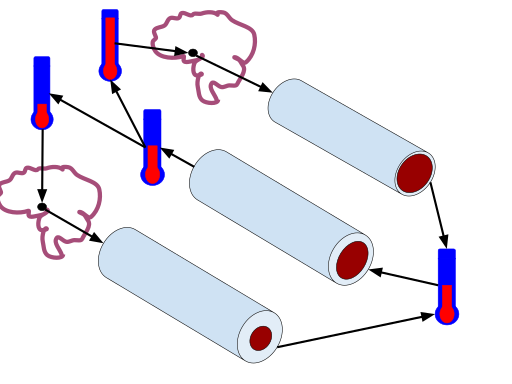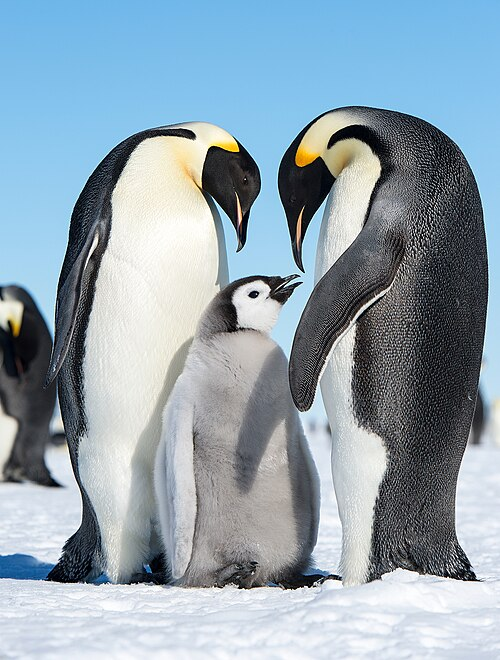OCR Specification focus:
‘Thermoregulation combines physiological mechanisms with behavioural strategies to maintain a relatively stable internal environment.’
Organisms integrate physiological and behavioural mechanisms to maintain core body temperature and ensure enzyme activity and metabolic processes remain optimal, allowing survival across changing environmental conditions.
Integrating Physiological and Behavioural Control
Endothermic animals, such as mammals and birds, use a combination of internal physiological responses and external behavioural adaptations to regulate body temperature. This integrated system ensures that temperature remains close to an optimum despite environmental fluctuations. Effective homeostatic thermoregulation is achieved through communication between sensory receptors, the brain (particularly the hypothalamus), and effectors in muscles, skin, and glands.
Coordination Between Systems
The nervous and endocrine systems cooperate to integrate thermoregulatory control:
The nervous system provides rapid, short-term responses via nerve impulses.
The endocrine system complements this with slower, longer-lasting hormonal changes.
Together, these systems ensure continuous adjustment to maintain the core temperature set point.
Homeostasis: The maintenance of a stable internal environment within narrow limits, despite changes in external conditions.
Physiological Mechanisms of Temperature Control
Physiological mechanisms are automatic internal responses that adjust heat production or heat loss. These mechanisms are coordinated by the hypothalamus, which acts as the thermoregulatory centre.
Temperature Receptors and the Hypothalamus
Peripheral temperature receptors in the skin detect changes in external temperature.
Core temperature receptors in the hypothalamus monitor blood temperature.
Information from both receptor types is integrated to initiate corrective responses through effectors.
Effector: A cell, tissue, or organ that carries out a response to a stimulus, restoring internal conditions toward the set point.-
Heat Loss Mechanisms (When Core Temperature Rises)
If the hypothalamus detects overheating, it stimulates mechanisms to increase heat loss and reduce heat gain:
Vasodilation of arterioles near the skin surface increases blood flow to capillaries, allowing more heat to radiate away.
Sweating: Sweat glands secrete fluid onto the skin surface; evaporation removes latent heat of vaporisation.
Reduced metabolic rate: The body decreases respiration rate to reduce internal heat generation.
Hair erector muscles relax, causing hairs to lie flat, reducing insulation.
Behavioural responses accompany these changes:
Seeking shade or water.
Reducing activity to limit muscle-generated heat.
Spreading limbs to increase surface area for heat loss.
Heat Conservation and Production (When Core Temperature Falls)
When the body is too cold, the hypothalamus coordinates heat conservation and production responses:
Vasoconstriction: Arterioles constrict, reducing blood flow to the skin surface to minimise heat loss.
Shivering: Rapid muscle contractions generate heat from respiration.
Increased metabolic rate through thyroxine and adrenaline release increases heat generation in cells.
Hair erector muscles contract, trapping an insulating air layer close to the skin.
Behavioural responses support physiological ones:
Moving into sunlight or sheltered areas.
Curling up to reduce surface area exposed to cold air.
Increasing voluntary movement to generate metabolic heat.
Integration of Behavioural and Physiological Responses
The integration of both types of control is essential. Physiological mechanisms act automatically, but behavioural actions complement them by modifying exposure to environmental heat or cold.
For instance:
An overheated endotherm may sweat (physiological) and seek shade (behavioural).
A cold endotherm may shiver (physiological) and huddle with others (behavioural).
This integration ensures energy efficiency. Behavioural changes often precede or reduce the need for energy-expensive physiological responses.
Role of the Hypothalamus in Integration
The hypothalamus acts as the central coordinating hub:
Receives sensory input from temperature receptors.
Compares data to the set point temperature (around 37°C in humans).
Triggers either heat gain or heat loss mechanisms via nerve impulses and hormonal pathways.
It sends impulses to effectors like sweat glands, muscles, and blood vessels while influencing hormone release through the pituitary gland, integrating both nervous and endocrine control.
The Importance of Feedback Loops
Thermoregulation operates through negative feedback mechanisms.
Negative Feedback: A control process where a change from the set point triggers responses that counteract the deviation, restoring equilibrium.
Example:
A rise in core temperature above the set point causes activation of cooling mechanisms.
Once the temperature normalises, these responses are inhibited.
Negative feedback restores core temperature towards the set point by coordinating antagonistic effectors.

Diagram of the negative feedback loop in body temperature control. Rising temperature triggers hypothalamic signals producing cutaneous vasodilation (heat loss), whereas cooling drives vasoconstriction (heat conservation). The image focuses on vascular effectors; sweating and shivering are not depicted but act in parallel. Source.
Occasionally, positive feedback amplifies change, such as during fever, where body temperature temporarily rises to inhibit pathogen activity.
Communication Pathways in Thermoregulation
Sensory Input: Peripheral and hypothalamic receptors detect temperature change.
Processing: The hypothalamus compares actual temperature with the set point.
Response Coordination: Via motor neurones (autonomic nervous system) and hormonal signals.
Effector Response: Physiological adjustments (e.g. vasodilation) and behavioural actions (e.g. seeking shade).
This forms a coordinated feedback loop, ensuring continuous monitoring and adjustment.
Comparative Examples of Integration
Humans
In heat: sweating, vasodilation, reduced activity.
In cold: shivering, vasoconstriction, wearing more clothing (behavioural).
Other Endotherms
Birds: fluff feathers to trap air; migrate or seek thermal shelters.
Mammals such as foxes: alter posture, burrow, or change activity timing (nocturnal vs diurnal).
Behavioural thermoregulation includes huddling, orientation to the sun, seeking shade or water, changing posture and altering activity.

Huddling reduces exposed surface area and cuts convective and radiative heat loss, integrating with physiological mechanisms to maintain core temperature. The image shows a dense group formation, typical in high winds and sub-zero temperatures. This real-world example illustrates the behavioural arm of thermoregulatory control. Source.
Ectothermic Comparison
While ectotherms rely more heavily on behaviour (e.g. basking, hiding), endotherms integrate internal regulation with behavioural choice, allowing more stable internal conditions.
Energy Balance and Adaptation
The integration of control mechanisms ensures energy balance is maintained:
Behavioural responses often reduce the need for high metabolic expenditure.
Physiological adjustments fine-tune body temperature when environmental changes are extreme.
Long-term adaptation (e.g. thicker fur, altered blood flow patterns) complements short-term homeostatic responses.
This dynamic integration underlies the ability of endothermic organisms to thrive in diverse habitats while maintaining stable internal conditions essential for survival.
FAQ
The hypothalamus acts as the body’s central thermostat. It detects changes in core blood temperature and receives input from peripheral thermoreceptors in the skin.
When a deviation from the set point occurs, the hypothalamus:
Activates autonomic responses such as vasodilation, vasoconstriction, or shivering.
Sends signals to higher brain centres to trigger behavioural adjustments, such as seeking shelter or reducing activity.
This dual coordination ensures rapid physiological correction while guiding energy-efficient behavioural choices.
Behavioural adjustments often occur before physiological mechanisms need to act, conserving metabolic energy.
Examples include:
Seeking shade or burrowing before overheating.
Huddling to share body warmth and reduce individual energy expenditure.
Changing posture to control exposed surface area.
By altering exposure rather than relying solely on internal processes, organisms maintain temperature without overusing stored energy reserves.
Camels orient their bodies relative to the sun and tolerate wider core temperature fluctuations to minimise water loss.
Penguins huddle in rotating groups to share warmth while allowing individuals periodic exposure to cooler air.
Elephants use ear flapping to increase convective cooling through large, vascularised surfaces.
Each behaviour complements physiological mechanisms, demonstrating species-specific integration suited to different environments.
Acclimatisation refers to gradual physiological and behavioural adjustment to seasonal or environmental change.
During cold periods:
Metabolic rate may increase through enhanced thyroid activity.
Animals might grow thicker fur or store more subcutaneous fat.
Behaviourally, they may alter daily routines, becoming more nocturnal or diurnal depending on temperature extremes.
This improves efficiency of thermoregulation without major genetic adaptation.
If integration fails, the organism may suffer from hyperthermia (overheating) or hypothermia (excessive cooling).
Possible causes include:
Neurological damage affecting hypothalamic function.
Hormonal imbalance disrupting metabolic control.
Inability to perform behavioural responses due to injury, confinement, or environmental restriction.
Without coordinated mechanisms, homeostasis breaks down, impairing enzyme activity, metabolism, and overall survival.
Practice Questions
Question 1 (2 marks)
Explain how both physiological and behavioural responses help an endotherm maintain its core temperature when exposed to very low environmental temperatures.
Mark Scheme:
1 mark for a physiological response: e.g. vasoconstriction reduces blood flow to skin to minimise heat loss / shivering generates heat from muscle contractions.
1 mark for a behavioural response: e.g. seeking shelter, huddling, or curling up to reduce surface area exposed to the cold.
Question 2 (5 marks)
Describe and explain how the hypothalamus coordinates physiological and behavioural mechanisms to regulate body temperature in an endothermic animal.
Mark Scheme:
1 mark: The hypothalamus detects changes in core temperature via thermoreceptors.
1 mark: It compares the actual temperature to a set point and initiates corrective responses.
1 mark: Physiological responses coordinated via the autonomic nervous system, e.g. vasodilation, vasoconstriction, sweating, or shivering.
1 mark: Behavioural responses coordinated by the brain, e.g. seeking shade or warmth, changing posture, or altering activity levels.
1 mark: Together these mechanisms act through negative feedback to restore temperature to the normal range.

